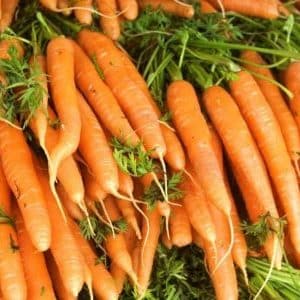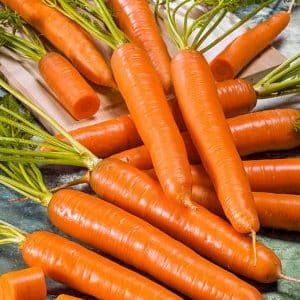Early maturing carrot hybrid with excellent yield: Amsterdam
An early ripening hybrid of Amsterdam carrots has increased yield and sweet bright orange pulp. The crop is easy to grow even for novice gardeners, following simple rules of agricultural technology.
Description of Amsterdam carrots
The culture has not lost its popularity for 30 years due to its ease of cultivation, excellent taste and versatility of use.
Origin and development

The hybrid was bred by Polish breeders in the mid-90s. In Russia, it was first grown in the Central Black Earth region, then it began to be cultivated everywhere.
The culture has taken root well both in the southern regions, and in the Urals, Siberia, and even the northern regions.
Chemical composition, trace elements and vitamins, beneficial properties
In terms of its chemical composition, Amsterdam is one of the advanced hybrids and has a rich list of vitamins and microelements.
Carrots contain microelements important for the human body:
- aluminum;
- boron;
- vanadium;
- iron;
- iodine;
- cobalt;
- lithium;
- manganese;
- copper;
- molybdenum;
- nickel;
- rubidium;
- selenium;
- strontium;
- fluorine;
- chromium;
- zinc.
All microelements in combination with each other have a beneficial effect on the functioning of systems and organs and are well absorbed when consumed.
Among the vitamins contained in the root vegetable:
- B vitamins: thiamine, riboflavin, pantothenic acid, pyridoxine, folic acid.Provide the body with immune support; normalize the functioning of the cardiovascular and nervous systems; improve skin condition and intestinal function; participate in energy exchange; protect the body from stress and muscle tension.
- Vitamin PP or nicotine, the benefit of which is the removal of “bad” cholesterol, participation in fat metabolism, hormone production, normalization of the liver and gastrointestinal tract.
- Beta-carotene, necessary for the body to maintain visual acuity and bone growth, accelerate the healing of wounds and abrasions.
- Vitamin C or ascorbic acid - a strong antioxidant, without which it is difficult for the body to cope with inflammatory processes.
- Vitamin E – an indispensable element of youth. Fights premature aging of the body, supports the immune system, removes free radicals and toxins.
- Vitamin H - a catalyst in metabolic processes, promotes the production of collagen and insulin, improves liver function.
- Vitamin K strengthens capillary walls and ensures blood clotting.
Ripening period
This is one of the earliest carrot hybrids. From the emergence of seedlings to technical ripeness, only 80 days pass. If the seeds are sown at the end of April - beginning of May, then the root crops are consumed already in mid-August.
Productivity
Another advantage of the hybrid is its high yield. From one sq. m harvest from 3 to 5 kg of vegetables. If all rules of agricultural technology are observed, the yield increases to 7 kg.
Disease resistance
Not every carrot hybrid can boast of such disease resistance as the Amsterdam carrot. Diseases affect it extremely rarely - this happens when the watering regime is not followed or unfavorable weather conditions.
Characteristics, description of appearance, taste

The leaves of the plants are dense, have a bright green color, the shape of which is semi-spreading rosettes. The height of the sprouts reaches 50 cm. Root vegetables: bright orange, cylindrical in shape with a blunt tip and a small core. The size of the vegetable is 15-20 cm, weight 150-180 g. The pulp is juicy and tender, with a high sugar content and a delicate aroma.
For which regions is it most suitable and what are the climate requirements?
Due to its undemandingness to soil and air temperature, Amsterdam grows throughout Russia. But the best harvest is obtained in areas with a temperate climate. The hybrid has proven itself well in the Central region, the southern regions of Siberia and the Far East.
Optimal climate for a hybrid: moderately humid, not hot and not dry.
The main advantages and disadvantages of a hybrid
The main advantages of Amsterdam carrots:
- ripens earlier;
- not demanding on soil composition;
- has increased productivity;
- resistant to diseases and blooms;
- unpretentious in care;
- distinguished by the uniformity of root crops with a blunt tip;
- has increased sugar content;
- universal in use: good both fresh and processed;
- They are planted not only in spring, but also before winter.
The hybrid has few disadvantages:
- crop loss during long-term storage;
- demands on watering;
- susceptibility to a number of diseases.
Features of planting and growing
The key to a high yield is proper preparation of the seeds, planting site and soil.
Preparing for landing

To improve germination, seeds are soaked in lightly salted water for 15-20 minutes. The seeds that float to the surface are removed as empty and unusable, the rest are dried.To speed up the development of the plant, place the seeds for 1-3 days in a damp cloth with the addition of an ash solution - a natural growth biostimulator.
Soil requirements
The place for sowing is chosen carefully: open, sunny, without shading.
The soil is prepared by adding humus, ash and peat. It is also recommended to add sand - the soil structure becomes looser, allows air to pass through, retains moisture and allows the carrots to penetrate deeper into the fertile layers of the soil, stretching in length without bending.
Predecessors
Carrots are not planted in the same place for two years in a row. Select ridges where the predecessors were legumes, cucumbers or cabbage.
Dates, scheme and rules of planting
There are two options for sowing seeds according to the timing: early spring (end of March - all of April) and late autumn (November).
Important! If the option of autumn planting is chosen, then the seeding rate increases by 40%, since the germination rate of winter sowing is lower.
Seeds are sown to a depth of 1-1.5 cm, the distance between rows is 20 cm.
Features of cultivation
There are several subtleties of obtaining a high yield of Amsterdam:
- to repel pests, onions, garlic, marigolds, and calendula are planted in neighboring beds;
- Since the sowing depth is small, the soil is compacted well with your hands so that during the first watering or heavy rains the seeds do not end up on top of the earthen layer and get lost.
Nuances of care
Caring for Amsterdam is simple, the main thing is to follow the watering regime, fight weeds and pests, and on time feed.
Watering mode
To form juicy root crops, water every 2 days in dry weather and 2 times a week as usual.
Important! It is necessary to spill the soil generously to a depth of 30-35 cm.The deeper the root crop seeks moisture, the more even its structure will be.
The next day after watering, the soil is loosened, preventing the formation of a crust.
Thinning and weed control
As the plants grow and thicken, the carrots are thinned out, leaving 4-5 cm gaps between the root crops. This is done several times a season. Remove those sprouts that are not strong and develop poorly.
Weed control is another condition for a good harvest. Weeds take nutrients from the soil and do not allow the plant to fully develop.
Top dressing
Amsterdam does not require frequent feeding, but will certainly respond to it with intensive growth.
Feeding rules:
- The first is applied two weeks after germination with a liquid solution of wood ash (2 cups per 10 liters of water)
- The second - three weeks after the first ammonium nitrate (2 tablespoons per 10 liters of water)
- The third - nitrophoska (3 tablespoons per 10 liters of water).
Disease and pest control
The hybrid is resistant to diseases, but some of them can affect the plant if not properly cared for:
- white rot, which is visible at the base of the fruit, is destroyed by spraying with the Baikal preparation;
- black rot that forms on green shoots and roots is destroyed by watering the plant with potassium chloride (50 g per 10 liters of water).
Pests on hybrid - a rare phenomenon if the rules of agricultural technology are followed.
The most dangerous guests on the bushes:
- carrot fly, the larvae of which gnaw root crops, appear when the soil is waterlogged. Watering is stopped for several days and sprayed with Intavir.
- carrot psyllid spreads where there are coniferous plantations nearby. The fight against it consists of spraying with tobacco infusion and removing weeds.
- Voracious slugs they start from excessive moisture and dense planting. Avoid stagnation of water and thin out the plants.
Harvest and storage
To keep carrots longer and preserve all its beneficial properties, it must be collected and prepared for storage on time.
How and when to collect
80-90 days after germination, the hybrid is ready for harvesting. Choose a dry and sunny day. Carefully remove the root crops from the ground and place them in a shady place to dry. The drying process takes 4-6 hours. Then the tops are cut off and placed in a vegetable storage room.
Storage features and shelf life of the hybrid
The best way to store carrots is to place the roots in sandbags. Place the carrots in storage, where the average temperature is maintained from 0 to 10°C.
Amsterdam is not one of the hybrids with a long shelf life, so you should not grow it in large quantities.
What difficulties may there be when growing
Sometimes vegetable growers face problems:
- cracking of the root crop: this occurs with irregular watering;
- ugly root crops: the reason is excess nitrogen fertilizers;
- carrots with hairy roots: the soil is not fertile, watering is irregular.
Advice from experienced gardeners
Advice from experienced farmers will help increase yields and cope with common problems in growing hybrids.
Valery Medvedev, experienced vegetable grower, Central District: «To prevent Amsterdam root vegetables from cracking, regularly water the carrots to the depth of the root layer, especially during dry periods. The interval between waterings is about 5 days.”
Olga Kostenko, Belgorod: “It’s more convenient to thin out a hybrid with tweezers - grab the carrot sprout and carefully pull it out of the soil. Then the soil around the remaining plants is lightly crushed, and the torn tops are removed away from the beds.”
Reviews of the Amsterdam carrot hybrid
Farmers love the hybrid and willingly share their impressions on thematic forums. Let's give a few examples below.
Regina, Kirov: “I’m very pleased that I chose this particular hybrid. I managed to save carrots until spring. The result is rich juices for the child.”
Inessa, Orenburg: “This year I planted Amsterdam for the first time. The carrots grew quite large and very juicy. The tops are large, and so are the root crops. It tastes sweet, and the color is pleasing to the eye – bright orange.”
Lidia Petrovna, Ekaterinburg: “We only plant Amsterdamse in our dacha. We sow directly into the ground and then fertilize several times. Stores very well in sand in the basement. Until spring, all carrots are juicy and hard.”
Conclusion
So, the Amsterdam carrot hybrid is a valuable, nutritious, healthy vegetable. If you make it a frequent guest on the table, you can forget about many health problems. It is not difficult to grow it - just follow simple rules of agricultural technology.